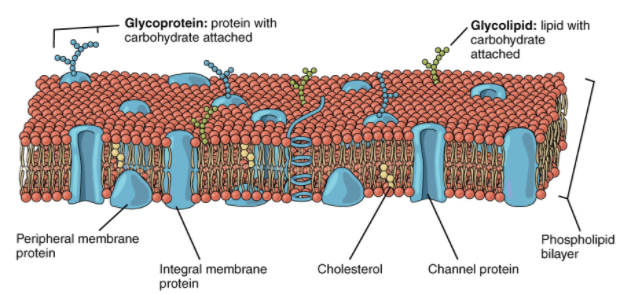
Explain the structure of the plasma membrane as proposed by Singer and Nicolson (1972), with a diagram.
Answer
566.7k+ views
Hint: Plasma membrane is the protective covering around the cell. It protects the cell from the external surroundings. Singer and Nicolson proposed fluid mosaic membranes to explain the structure of plasma membranes.
Complete Answer:
Singer and Nicholson proposed the fluid mosaic membrane in order to explain the structure and function of the plasma membrane. According to this model lipid layer is spread which acts as a flexible layer. The protein molecules are the channels through which the bio-molecules enter and exit the cell.
Structure
The fluid mosaic membrane says that the plasma membrane is a mosaic which is made up of phospholipids, carbohydrate and cholesterol and the protein gives the membrane a fluid character.

The proteins present are called the globular protein which is of two types- Intrinsic and extrinsic. The extrinsic proteins are soluble and move to and fro from the membrane whereas the intrinsic are insoluble and embedded on the surface.
The Bilayer is composed of lipid matrix is fluid like which helps in movement of the components. Phospholipids are made up of glycerol and fatty acid. They have a hydrophilic head and hydrophobic tail. The polar head contains glycerol and phosphate and nonpolar consists of fatty acid. All non-polar groups of phospholipids are in contact with the neighbouring non-polar molecules. The polar groups are present outside. This arrangement makes cell membrane semi fluid like.
Note:According to the fluid mosaic model protein acts as an iceberg in the ocean of phospholipids.The plasma membrane protects cells from damage. It is selectively permeable and allows only selected particles to move in and out of the membrane.
Complete Answer:
Singer and Nicholson proposed the fluid mosaic membrane in order to explain the structure and function of the plasma membrane. According to this model lipid layer is spread which acts as a flexible layer. The protein molecules are the channels through which the bio-molecules enter and exit the cell.
Structure
The fluid mosaic membrane says that the plasma membrane is a mosaic which is made up of phospholipids, carbohydrate and cholesterol and the protein gives the membrane a fluid character.

The proteins present are called the globular protein which is of two types- Intrinsic and extrinsic. The extrinsic proteins are soluble and move to and fro from the membrane whereas the intrinsic are insoluble and embedded on the surface.
The Bilayer is composed of lipid matrix is fluid like which helps in movement of the components. Phospholipids are made up of glycerol and fatty acid. They have a hydrophilic head and hydrophobic tail. The polar head contains glycerol and phosphate and nonpolar consists of fatty acid. All non-polar groups of phospholipids are in contact with the neighbouring non-polar molecules. The polar groups are present outside. This arrangement makes cell membrane semi fluid like.
Note:According to the fluid mosaic model protein acts as an iceberg in the ocean of phospholipids.The plasma membrane protects cells from damage. It is selectively permeable and allows only selected particles to move in and out of the membrane.
Recently Updated Pages
Master Class 12 Business Studies: Engaging Questions & Answers for Success

Master Class 12 Economics: Engaging Questions & Answers for Success

Master Class 12 English: Engaging Questions & Answers for Success

Master Class 12 Maths: Engaging Questions & Answers for Success

Master Class 12 Social Science: Engaging Questions & Answers for Success

Master Class 12 Chemistry: Engaging Questions & Answers for Success

Trending doubts
What is meant by exothermic and endothermic reactions class 11 chemistry CBSE

Which animal has three hearts class 11 biology CBSE

10 examples of friction in our daily life

One Metric ton is equal to kg A 10000 B 1000 C 100 class 11 physics CBSE

1 Quintal is equal to a 110 kg b 10 kg c 100kg d 1000 class 11 physics CBSE

Difference Between Prokaryotic Cells and Eukaryotic Cells




